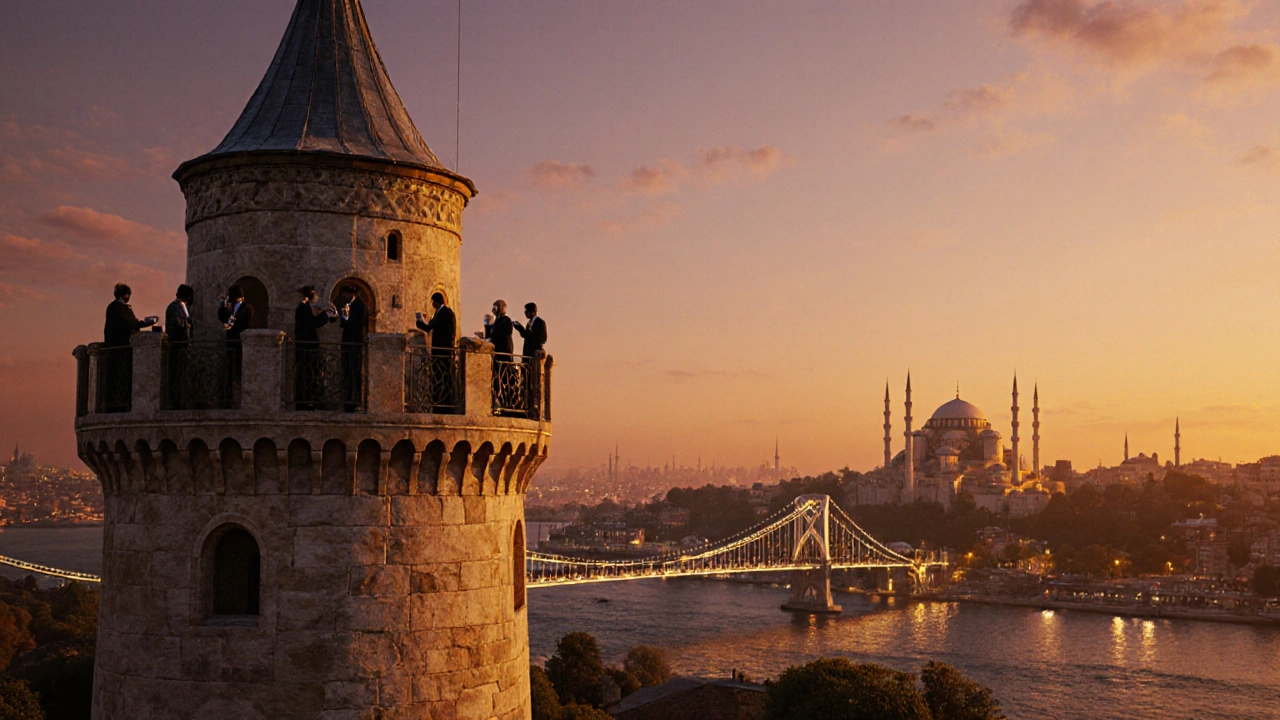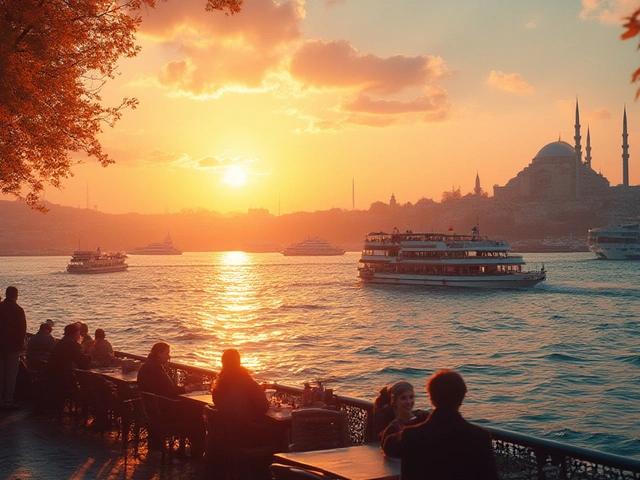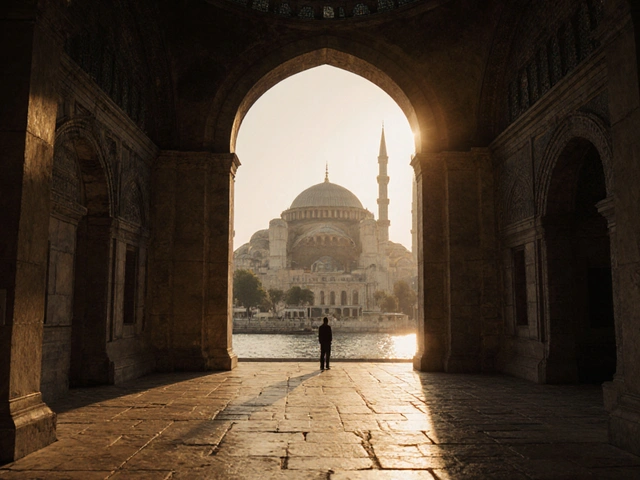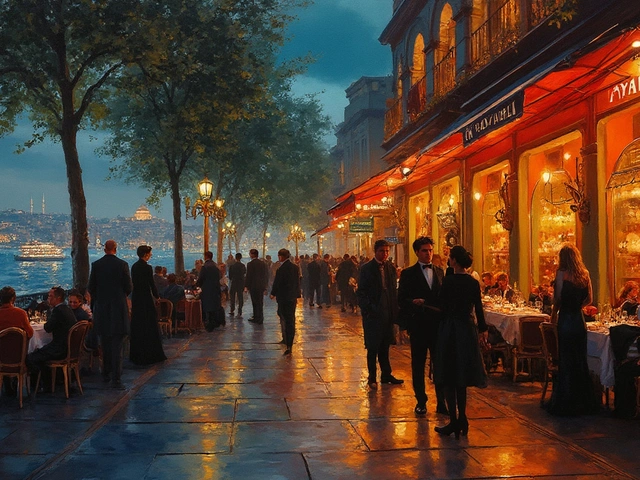When you stroll along the Bosphorus in Istanbul, the silhouette of Kız Kulesi - known worldwide as the Maiden's Tower - instantly catches the eye. But the tower is more than a pretty backdrop for sunset selfies; it’s a treasure chest of myths that have shaped the city’s identity for centuries.
What the Tower Is and Why It Matters
Maiden's Tower is a small stone structure perched on a tiny islet at the junction of the Asian and European shores of the Bosphorus. Built in the 12thcentury by Emperor Manuel I Komnenos, it has served as a watchtower, lighthouse, quarantine station, and today a trendy café that draws locals from Şişli, Kadıköy, and even expats in Beyoğlu.
The tower’s strategic position meant it guarded the imperial capital - now Istanbul - from naval incursions, but the real power of the site comes from the stories that have been whispered on ferry decks for generations.
Chronology: From Byzantine Guardpost to Modern Icon
- 12thcentury: Constructed as a Byzantine watchtower.
- 1453: Ottoman sultan MehmedII reinforced the structure after the conquest.
- 1860s: Turned into a lighthouse with a modern lantern.
- 1930s: Used as a quarantine station during the cholera outbreaks.
- 2000s: Restored and opened as a restaurant and event space.
Each era added a layer to the tower’s legend, intertwining fact with folklore.
Legend #1 - The Emperor’s Daughter and the Poisoned Snake
The most famous tale tells of an emperor who feared a prophecy that his daughter would die from a snake bite. To protect her, he built the tower on an isolated rock, thinking no snake could reach her. One day, a curious servant placed a basket of fruit on the tower’s balcony. A tiny viper hid inside, bit the princess, and fulfilled the prophecy.
This story is often recited by tour guides near Hagia Sophia, because the same emperor is linked to the Hagia Sophia’s construction. The moral? Fate can’t be outrun, even by the most fortified walls.
Legend #2 - Leander and the Lovers’ Bridge
Another romantic version swaps the snake for a love story. A young man named Leander fell for a maiden living on the islet. Each night, he swam across the Bosphorus, guided by a lantern she lit on the tower. One stormy night the lantern went out, Leander drowned, and the tower became a monument to tragic love.
Locals still reference this tale when they light candles on the tower’s café terrace during Valentine’s Day, a tradition that began in the 1990s at the “Mavi Balık” restaurant on the Asian shore.
Legend #3 - The Ancient Lighthouse Keeper
According to a lesser‑known Ottoman anecdote, a lighthouse keeper named Hasan refused to let a fire break out on the tower despite a raging storm. The fire’s light, however, guided an Ottoman fleet safely to the Golden Horn, saving the city from invasion. Today, the lighthouse’s beacon still rotates, echoing Hasan’s vigilance.
When you catch the Şehir Hatları ferry from Eminönü, you’ll see the rotating light and feel the same sense of protection that Hasan once provided.
Legend #4 - The Hidden Treasure of Sultan Suleiman
Some whisper that Sultan Suleiman the Magnificent stored a chest of pearls and gold inside the tower to fund the construction of the Süleymaniye Mosque. The treasure was allegedly buried beneath the floor and never recovered after an earthquake in 1766. Modern treasure hunters still claim to have heard “clinks” beneath the café’s wooden floorboards.
If you visit the tower’s upstairs balcony, you can sit where the alleged loot was hidden and enjoy a view of the Galata Bridge, a perfect spot for a Turkish tea break.
Comparing the Legends
| Legend | Main Characters | Core Theme | Historical Tie‑in |
|---|---|---|---|
| Emperor’s Daughter | Imperial princess, snake | Fate vs. protection | Byzantine watchtower era |
| Leander’s Love | Leander, maiden | Love and tragedy | Ottoman romantic poetry |
| Lighthouse Keeper | Hasan, Ottoman fleet | Duty and salvation | 19th‑century lighthouse upgrade |
| Sultan’s Treasure | Suleiman, hidden chest | Wealth & mystery | Golden Age of Ottoman architecture |
How Istanbul Locals Keep the Stories Alive
Every summer, the İstanbul Maritime Museum hosts a “Legends of the Bosphorus” exhibition, featuring interactive maps, old Ottoman navigation tools, and a replica of the tower’s ancient lantern. The event draws school groups from Kadıköy’s “İstanbul Anadolu Lisesi” and art students from Mimar Sinan Fine Arts University.
Restaurants nearby-like “Sarnıç” on the shore of Üsküdar-serve a “Kız Kulesi” platter, a seafood mix inspired by the tower’s maritime history. Ordering it is a subtle way for locals to show pride in their heritage.
Practical Visiting Tips for the Curious
- Buy a round‑trip ticket from the Şehir Hatları line at Eminönü or Kadıköy; the ferry runs every 30minutes and costs roughly 25TL.
- Arrive early (7a.m.-8a.m.) to avoid the crowd that gathers for the morning brunch.
- Bring a lightweight jacket. The tower’s altitude can feel breezy even in late summer.
- Take the stairs to the top balcony for the best panoramic shot of the Bosphorus, the Bosphorus Bridge, and the historic skyline.
- Try the “Çay on the Tower” set; it includes a traditional Turkish tea served in a brass pot, a nod to Ottoman hospitality.
- If you’re interested in history, ask the staff for the “legend brochure” - a printable PDF that the Istanbul Metropolitan Municipality distributes for free.
These tips are useful whether you’re a resident of Beşiktaş planning a weekend outing or a visitor staying at a boutique hotel in Sultanahmet.
Preservation Efforts and Future Plans
The Istanbul Metropolitan Municipality partnered with the Turkish Ministry of Culture in 2022 to launch a restoration project that reinforced the tower’s foundation while preserving its original limestone façade. The project also installed solar panels to power the café’s lighting, aligning the ancient structure with modern sustainability goals.
Looking ahead, a cultural center is slated to open by 2026, featuring rotating exhibits on Bosphorus folklore, interactive VR experiences of the legends, and workshops for local schools.
Key Takeaways
- The tower’s multiple legends reflect Istanbul’s blend of imperial power, romance, and maritime duty.
- Each story ties to a specific historical period, from Byzantine watchtowers to Ottoman golden age.
- Local traditions-ferry rides, café culture, and museum exhibitions-keep the narratives alive today.
- Visiting the tower is easy with regular Şehir Hatları ferries; plan for early mornings to enjoy quieter moments.
- Ongoing preservation ensures that future generations can experience both the architecture and the myths.
Frequently Asked Questions
How do I get to Maiden's Tower from the European side?
Take a Şehir Hatları ferry from Eminönü or Karaköy to the small pier opposite the tower (called Kız Kulesi iskele). The ferry drops you within a short walking distance, and a short boat ride from there brings you to the tower itself.
Is there an entrance fee?
Yes. As of 2025, an adult ticket costs 45TL, which includes the ferry round‑trip and access to the café and balcony. Discounts are available for students and seniors.
Can I host a private event on the tower?
The cultural center plans to offer private bookings starting in 2026. Currently, small groups can reserve a corner of the café for birthday celebrations, but larger events need special permission from the Istanbul Metropolitan Municipality.
Which legend is most popular among Istanbul’s youth?
The Leander love story resonates the most, especially after being featured in recent Turkish pop songs and a Netflix series that filmed scenes on the tower’s balcony.
Are there any accessibility options?
The tower has a small elevator (installed during the 2022 restoration) that serves the ground floor and the café level. The top balcony is still accessed by stairs, so fully wheelchair‑accessible access is limited to the lower levels.
Whether you’re sipping çay on the balcony, listening to a guide retell the ancient snake tale, or simply watching the sun set over the Bosphorus, the stories that make Maiden's Tower unique are a living part of Istanbul’s cultural fabric.













10 Comments
The tower’s layered history illustrates Istanbul’s evolving maritime role.
Ah, so you’ve reduced centuries of myth to a dry syllabus-how thrilling. The real magic lives in the snake‑bit princess and Leander’s doomed swims, stories that still echo in the cafés and pop songs. Those legends aren’t just footnotes; they’re the cultural DNA that draws tourists to sip çay on the balcony. You can’t capture that vibe with a bland chronicle alone.
The Maiden’s Tower stands as a microcosm of the broader geopolitical flux that has characterized the Bosphorus corridor since the twelfth century. Its initial function as a Byzantine watchpost underscores the strategic imperative of controlling maritime passage between Europe and Asia. The Ottoman reinforcement under Mehmed II not only reaffirmed the tower’s defensive utility but also symbolized the continuity of imperial oversight across successive regimes. The conversion to a lighthouse in the nineteenth century reflects the modernizing impulses of the Tanzimat era, wherein technological advancement was harnessed to secure commercial navigation. The subsequent employment as a quarantine station during the cholera outbreaks of the 1930s illustrates the adaptive reuse of historic architecture for public health imperatives. Today, the tower’s reincarnation as a café and cultural venue demonstrates a sophisticated synthesis of heritage preservation and contemporary tourism economics. Moreover, the multiplicity of legends associated with the site-ranging from the fatal serpent of the imperial daughter to the tragic romance of Leander-function as narrative strata that enrich the visitor experience. These stories are not merely anecdotal; they serve as pedagogical tools that transmit communal values of fate, love, and duty across generations. The legend of Hasan, the steadfast lighthouse keeper, exemplifies a moral paradigm wherein individual vigilance safeguards collective security, a motif resonant with the Ottoman naval ethos. Equally, the whispered tale of Sultan Suleiman’s hidden treasure invites speculation regarding the material motivations that often accompany monumental patronage. Recent archaeological surveys have, in fact, identified anomalous voids beneath the tower’s floorboards, lending a modicum of credence to the treasure narrative, though definitive evidence remains elusive. The forthcoming cultural centre, slated for 2026, promises to institutionalize these narratives through interactive exhibitions, thereby fostering an immersive educational environment. Such initiatives align with the Istanbul Metropolitan Municipality’s broader strategy of leveraging intangible heritage to augment the city’s soft power on the global stage. From an urban planning perspective, the integration of solar photovoltaic systems into the tower’s energy grid epitomizes a commendable model of sustainable retrofitting for historic sites. In sum, the Maiden’s Tower encapsulates a symbiotic convergence of architectural continuity, mythic resonance, and adaptive reuse, rendering it an indispensable locus for scholars and tourists alike.
Sure, the “intangible heritage” spiel sounds fancy, but let’s be real-most visitors just wanna snap a selfie with the “legendary” snake tale in the background. The supposed “voids” under the floor? Probably just old storage cavities, not a pirate’s stash. You can’t rely on vague surveys to prove a myth, yet the tourism board will definitely capitalize on any rumor. It’s a classic case of marketing over scholarship.
What nobody tells you is that the tower’s modern renovations are a front for covert surveillance operations. The new solar panels aren’t just eco‑friendly; they double as power sources for hidden cameras that monitor ferrymen and tourists alike. Every “cultural centre” plan is layered with governmental data‑harvesting agendas, disguised as heritage preservation. Citizens should question who truly benefits from these glossy brochures.
The concerns about privacy are understandable however the primary goal of the upgrades appears to be structural safety and energy efficiency. The municipality has issued statements emphasizing transparency in the project.
Deploying heritage‑centric narrative frameworks without rigorous source triangulation results in a memetic flattening of cultural epistemology. Your reliance on pop‑culture references to validate historical veracity is, frankly, a reductive semiotic shortcut. While the tower’s legends are undeniably marketable, academic discourse demands more than anecdotal reinforcement. The current discourse therefore oscillates between folkloric commodification and pseudo‑scholarly exposition.
Indeed; the commodification you describe-yet-cannot be divorced from the hegemonic mechanisms that perpetuate Euro‑centric historiography; thus, the Tower becomes a palimpsest of controlled narratives, engineered to sustain state‑sanctioned mythologization! Moreover, the very act of “marketable folklore” is a stratagem deployed by clandestine cultural ministries to subtly steer collective memory toward predetermined ideological endpoints.
Honestly the tower is just a cool spot to chill, grab some tea and snap a view of the bridge without overthinking all the back‑story. It’s where locals unwind after work and tourists get a quick bite.
Don’t be fooled by that “just a chill spot” line – it’s a soft‑power ploy to distract you while the city pushes its agenda of cultural uniformity. Every casual hangout is curated to dilute authentic local voices and replace them with a homogenized tourism script. Wake up and see the bigger picture.